Let's dig deeper into this war of mine: what's in game mechanics?

The game is brilliant. A year ago, she blew up a bunch of publications about how quickly and effectively the horrors of war are brought to the player. Therefore, I propose to climb a little "under the hood." Immediately I say - the game is not ours, and it has no relation to us.
In general, I’ll probably be going to talk about gamedev hardcore for a couple of months, more precisely, what our colleagues call game science. I'll start with simple and clear things. With far from perfect igromechanika, working at the same time as a clock. Or like a blow to the head.
')
So, let me remind you: the main task of the game is to plunge a person into the state of “being civil in a war and try to survive”, so that even the most frostbitten can understand how bad it is. Accordingly, everything else is built around this. At the same time, the game itself should be:
- Interesting.
- With a simple entry threshold.
- Realistic for immersion tasks.
Clearly, the creators of a little namuleval - but it becomes noticeable only after a detailed analysis. Clearly, the setting logic sometimes argues with mechanics and gameplay. It is clear that a lot of flaws, but in general - very cool. Therefore, we went to dig to the smallest detail.
Attention , below are some spoilers and a lot of screenshots (traffic).
Entry curve
So, you play for a small group of comrades who survive in the outskirts of the city, where the fighting is conducted. There are three global "external" factors: the lack of food and necessary things (this is determined by the fact of war), the constant looting of marauders and thugs, plus a strong cooling in winter. The challenge is to go through it all. As in the novel "Marauder".

One of the most visually powerful screens of the game - start
This screen with beatings in the psyche "survived" on photographs - it does not open entirely at once. The first clickable stories provide a simple composition and a simple script.
The complexity of the game is determined by the scenario and the composition of the players.
The script is what happens around:
- The duration of the war (for example, 24 days is easier to survive than 47).
- The order of external events (on difficult stories, the game begins with the cold and huge bands of gangsters, on the lungs - with summer and calm).
- Time of the year (sometimes you need to warm up and look for cold pills for the whole game, sometimes - not at all).
- Plus available objects on the map. Their number and their sub-scenarios vary in complexity. For example, there may be such a situation that only those places where resources are difficult to get are available - such as a church, where instead of monks there are bandyuks, or a half-ruined school, where instead of homeless people there are militiamen.
- To a lesser extent, from scenario gaming events like guests bringing you something useful.
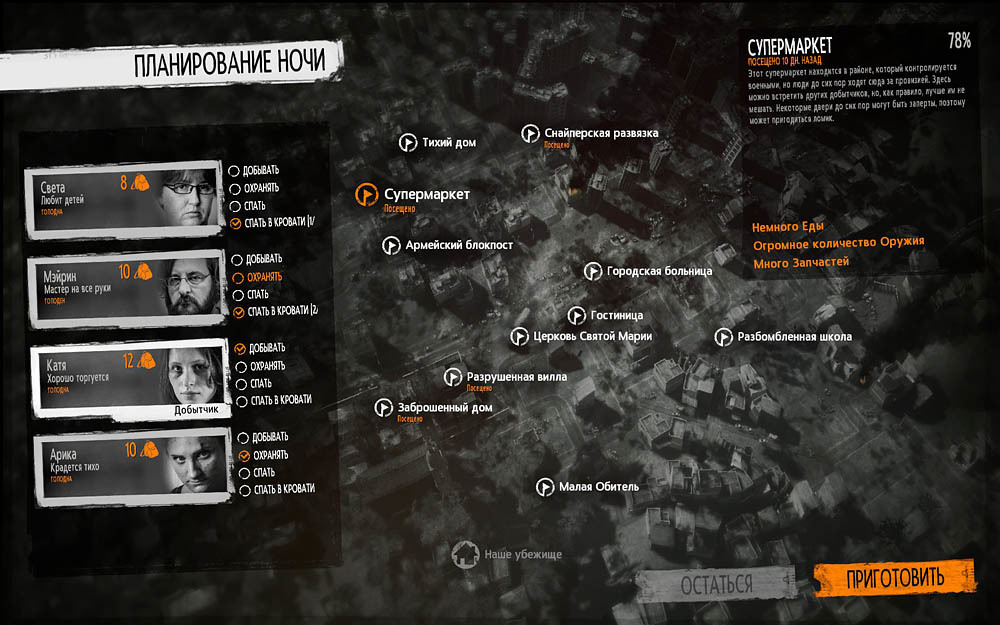
City map
The characters in the game are not all balanced: there are very cool, and frankly almost useless. The latter are needed just for the training aspect, but more on that below. Naturally, the initial composition of the "stars" also provides low complexity.

Gameplay and balancing
You start in an abandoned house, where you need to dismantle debris, open cabinets and generally build infrastructure such as stoves, workbenches, beds, and so on. This is already the first things for the game, and immediately the entrance to the atmosphere (I remember, I used a similar technique in the live action pavilion role-playing game about the consequences of an attack on the colony - in the room where the players went, everything was turned upside down, and so that feel what happened, "hands").

This is your base, a place for daytime gameplay. In the afternoon it is impossible to get out of the base: it is assumed that the street will immediately be shot without question. In this case, NPCs come to you and offer goods, help with something, or ask for help. Judging by some fragments of plot texts, some game part was supposed to establish relations with neighbors, but then, it seems, it was cut out and simplified to these “guests”.
On the base there is a workbench, from it you build the rest of the infrastructure. First of all - beds, bench, stove for cooking, heater or figovinu to collect water, for example. In an idle refrigerator are stored supplies, in the closet next to - drugs.
The basic balance is built around the missing food. You need to constantly go to the city at night (in different places) to collect food, boards, all kinds of components such as adhesive tape and nails, and so on. Clearly, if the houses managed to set up food production, you would not go out at all, and the game would be blown away. Accordingly, the first thing the game designer did was to establish the rule: “the house is not self-sufficient”.
This means that you can put traps on rats, but not more than two pieces. You can grow vegetables, but you still need meat and water. You can do something at home as a whole - but you will still need something outside. At the same time, it is possible to accumulate enough food on batches longer than 40 days, approximately on the 30th day, so that the next two weeks will not go anywhere at all.
You also constantly need components to improve your home - this is the second factor of balance.

At the beginning of the game, you need to hammer holes in the walls after the shelling, get all sorts of garbage to assemble tiles and other pieces, make an extremely scarce ax (an inhumanly difficult task in our world - it is often easier and faster to find a Kalashnikov machine than an ax). Accordingly, they need to go outside.

Character thoughts about base comfort
So, the game is divided into two encapsulated objects: base and night exits. With the same mechanics of the base as in XCOM. At the same time, the very shortage is heavy boards and components. Logically, it would be extremely easy to convey them, if you go in three at once and drag them. Or go character twice or thrice. But no. During the night - only one way out, and only one person.
In addition, each character has a capacity limit - this is another factor limiting the flow of resources, that is, also the level of complexity. Here are the inventory and items on the ground:

The second way to get resources, if you don’t go after them at night, is to buy from a merchant who comes into the base about once every 4 days.
At every object in the city there are valuable things and not so much. For example, a pistol, cans of canned food, jewels and medicines have a huge play value, and cigarettes, coffee, tobacco, sleeves, and so on - almost none. This is the second factor of balance: despite the fact that the characters are differently load-carrying, they will pull out the main things quickly. That is, the balance of food will converge, but on the boards - no. This only means slowing down the construction of the infrastructure of the base.
Accordingly, a merchant is needed to smooth out the wrong choice of a place to hike. If you find a diamond necklace with a diamond earring instead of a food barrette, the man will come and balance it with an exchange. That is, there will never be deliberately disastrous exits to the city. And this dude, although he carries with him a huge pile of everything (which is also not the gameplay), cannot be hit on the head and robbed (which would be very logical based on the plot further), and although it complains about snipers, it will always survive will come like a clock. The conclusion is simple: if you ever become an NPC in a computer game, try to be responsible for the balance. So you are completely safe.
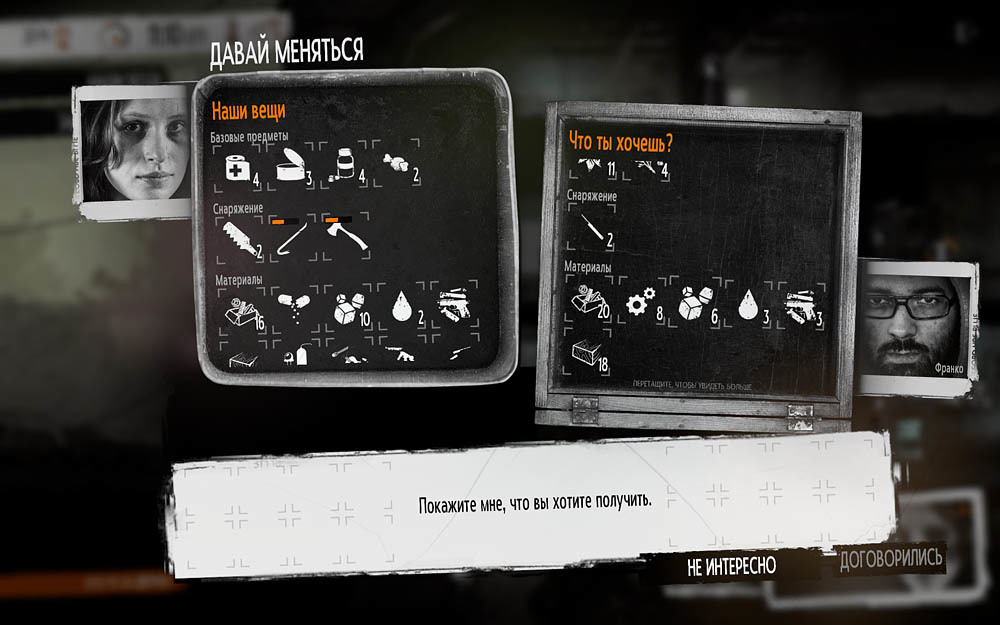
As you can see, igromechanically everything is cool, but realism is suffering severely. But we used to, this is a game.
The main problem igromehaniki opened in the second batch, when you begin to understand in detail what is needed from the base objects. Moonshine, improved chemical table, hydroponic bed, improved stove - all this costs so much in resources that simply does not pay off. Actually, if you know that the war ends in the horizon of 50 days, then the business plan of such investments does not converge. A much more effective strategy is that instead of processing resources like sugar into moonshine, simply drive them to the merchant raw. It is trite profitable, and it really cuts off some of the interest and depth of the game. This is all done for a simple reason - on the one hand, we need to create the need for resources in the middle and the end of the game, but how to do this without breaking the balance of the beginning is unclear. From here and such perversions. In addition, regardless of the order of the hike to the objects, you have to survive about the same way, which also requires balancing. Taking into account the missing preservations (or rather, returns to the past), the game designer decided that it would be a shame to go wrong and die from starvation or cold. This also affected the balance.

Base upgrade continues, see how much micromanagement
"Desktop" restrictions igromehaniki
There are a lot of strange things in the game, but they all relate to what we are accustomed to counting as game restrictions in board games. Again, considering how many times I meet the advice of experienced game designers to sharpen everything on paper prototypes, I suspect that there was a desk like in XCOM. Either the authors come from the desktop market. Accordingly, the same scheme of “cardboard” simplifications is used here:
- The military will never come to your house. The base is not attacked.
- Do not try to leave the city. Despite the obvious logic of such a decision, you need to sit in Pogoren on the spot and dig deeper and deeper into the house.
- Cartridges for all weapons of a single type. They climb into a shotgun, a sniper rifle, a pistol, and a machine gun. Igromechanically is a good simplification, because the game is not about that.
- The time in the game is abstract - from the edge to the edge of the house on foot - at least 20 minutes.
- Heating is determined solely by the cost of resources for heaters. Where and how are the stoves - it does not matter (visually a lot of extra space is heated), an open door does not affect the temperature of the house, the stove with food does not give heat. By the way, the bed with vegetables at -15 feels great, unlike the characters.
- The game "cheats" by generating random numbers - for example, when you have really little food, traps for rats begin to give more meat.
- The combat system is such that our “pacifist” Roman can easily cut out a whole checkpoint of soldiers. However, after the third patch, then it will begin to be morally killed.
- There are a lot of minor bugs ranging from the possibility of the fifth character in the group (and his unexpected loss) and ending with a glitch with repeated moral suffering. Plus, classically algorithmic ones like restrictions on the length of the search path stack.
- At the sites of the city, even abandoned, someone carefully placed the ladders in key places. No need to carry a ladder or rope with you - everything is there.
- On the stove, you can endlessly store ready-made food - and it will not even be taken away by marauders (they simply won't see it).
- The visual design of the house does not match the game mechanics and the plot. First, there is a lot of deliberately uncleared garbage remaining until the end of the game. Secondly, with the naked eye you can see a pile of wood that we cannot reach - for example, there is a table that cannot be chopped with an ax or the whole attic. Thirdly, it is not clear where inedible things are added - they, it seems, are somewhere here, but in fact - only in the interface.
- There are places to hide at combat sites, not ordinary ones. And you can still hide in such a way that three people who search everything will not find it.
At the same time, the game remains holistic. All this does not interfere, but in practice it serves one and only goal - to drag the player along exactly the desired plot.
History and plot
So, you already are familiar with everyday difficulties. It is worth adding that our heroes are still sick from the cold and, sometimes, just like that, they come from the exits wounded and sometimes they do not even behave very well. For example, to fight with other characters, without the demand to drink medical alcohol, to be hung up from depression and quit the work begun. All this determines the constant micromanagement.
The second most part of the game - it is also the main one in terms of plot impact - these are exits to the city. The first pair of points is abandoned houses, where the necessary items just lie somewhere nearby, and it is enough to assemble them.
Naturally, on this layer of the player it is necessary to take something. In the simplified case, we get such a mini-maze with igromekhanicheskim obstacles. In a more complicated way - interactions with characters in a peaceful (“Don't touch my things”) or battle mode. The same level can be played as combat, stealth "get to the refrigerator and first-aid kits" or "quietly taken at the edges of the house and ran away."
As well as at the base, the main resource is time. But if at the base this is solved by sleep, construction and constant spin-off of something small (throw the log into the stove, change the filter on the water plant, etc.), here it is different rubble like this:

Sometimes it is necessary to be afraid of noises (this is a rat, also a dangling window sash or a peasant with a shotgun may appear:)
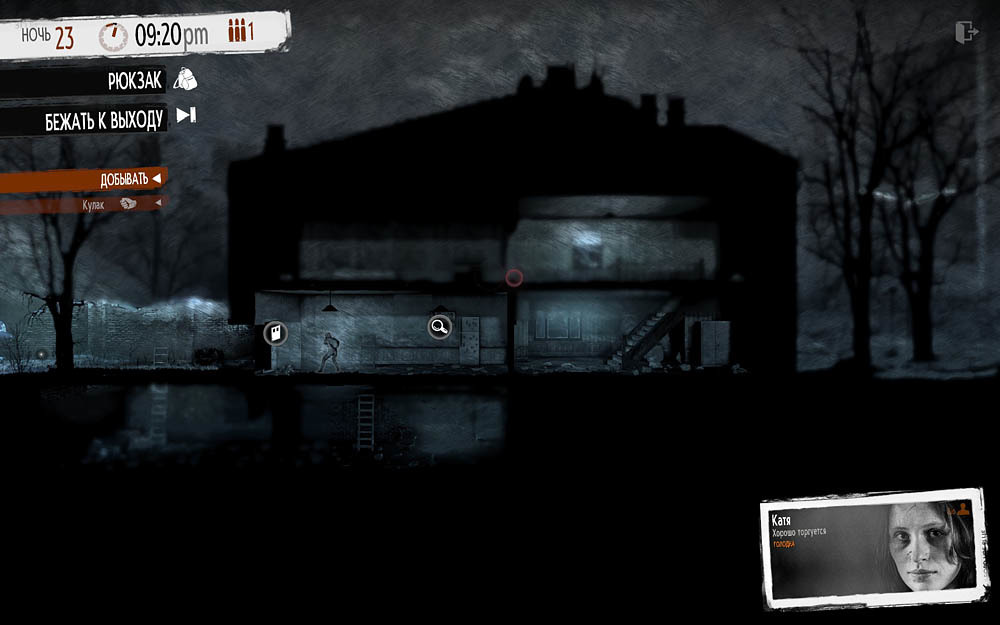
Locked grates (need a file) guard the treasure:

Doors-diodes: on the one hand they are boarded up and can be disassembled, on the other - do not open in any way. In life, these do not happen, but in the game they are needed:

There are, of course, ordinary doors that can be opened with a crowbar or master key.
Plot
The first and most important thing in the plot is moral choices every time you do something. Here, for example, a quiet house where an elderly couple lives. You can quietly leave, and you can break in and rob them (they will try to run away to the basement from the scary character):

Always everywhere - the traces of war. Every object in the city is someone's tragic story that develops with you or has already ended. For example, here is a note from an abandoned house:
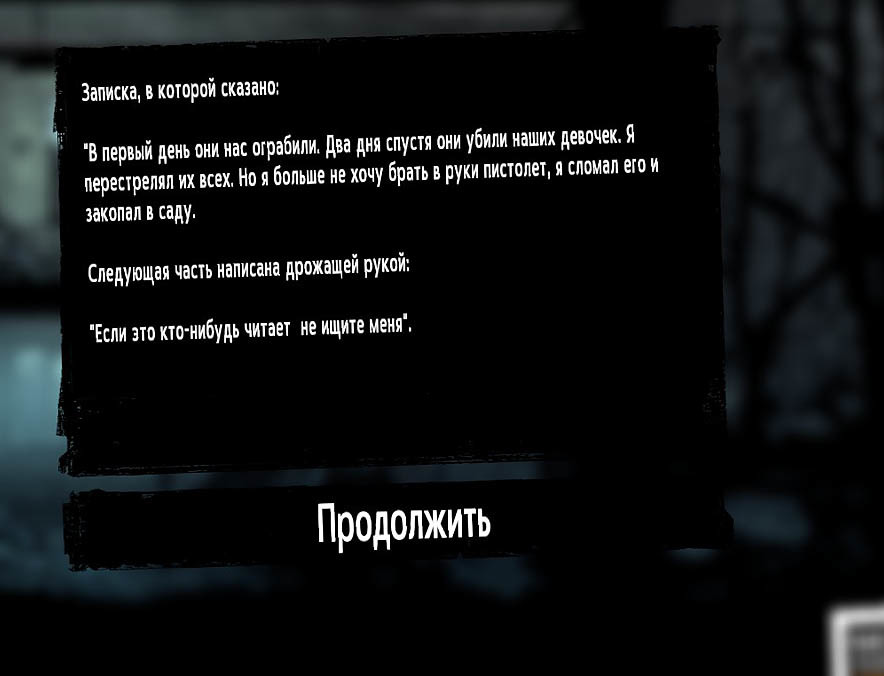
Here is one of the strongest moments of the game: a drunken, well-armed soldier and a girl. Given the lack of saving - either you try to do something, or you will stand and watch how he rapes her.

The second is a very strong moment with a sniper who shot down his father returning to the baby with medicine. Here is a very scary (visually) sniper snapshot, very well-chosen effects of flashing lights, good sound - and all this plays into the fact that in the end you understand how great it is that you helped.

Each choice means consequences. Here is the father gives us the jewelry:

Then we will see this story in the final game. Almost every object has a scripted scene, depending on its state. For example, you can catch a supermarket with a military man or with marauders (and they will rip it off in parallel with you - not less an eerie sight).
The next layer is “home stories,” for example, like this. This character wants to join us:

Sometimes it happens like this:

Here the militia asks to give out the person to whom we helped, and offers products for it. The point, as always, is very simple. Or something useful for the mean act - or you remain with a clear conscience, but without food. Of these choices is a game.
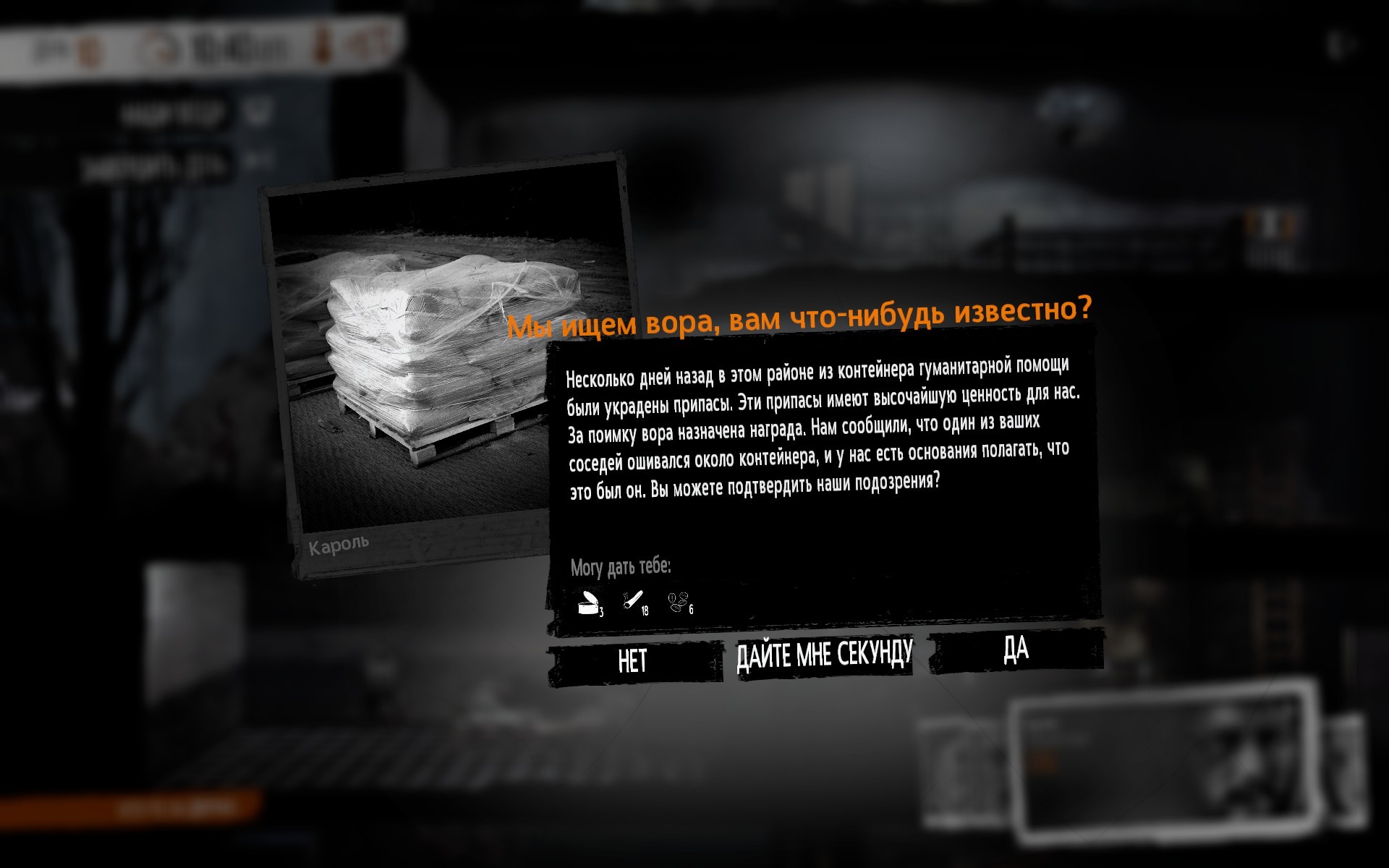
In the end, they line up in moments of war like this:

Nevertheless, it becomes very quickly clear that just like that, without additional incentives, it is more advantageous to be a Munchkin igromechanically.

Roman starts to cut out the checkpoint
Therefore, the game designer decided this way - grateful residents still bring something useful later:


This, too, was not enough. Munching was still easier. Therefore, they introduced another parameter - morality. If someone does something bad (according to his scale of values), he and others start to kill. The dull character just grumbles and gets worse, depression leads to night fights, scandals, chasing alcohol in the fridge, leaving home or wanting to hang himself. They pull out of depression with the help of persuasion in the spirit: “We need you to survive. Get up. ”

Each character keeps a “diary”, where he writes down thoughts about his actions.

Accordingly, in the diaries of other characters, this can be both condemned and perceived with praise.
In the final, if the characters did everything “right”, they feel good. If not, they feel bad. Another moment of learning. In real life, probably not like this:


Morale is visible throughout the game, yes, yes, yes. Pay attention to the biography of the novel. Villain can not go unpunished.
Now let's look at the interface
The first beautiful - learning dialogue. Characters directly report what they see fit to do. For example, at the first signs of cold snaps (still safe), they begin to remind about the stove.
Here is a similar Fallout Shelter with a similar character management system at the level of global mechanics. They also report their problems. This is the standard mechanic.
Characters "think out loud", and the player receives igrotechnic information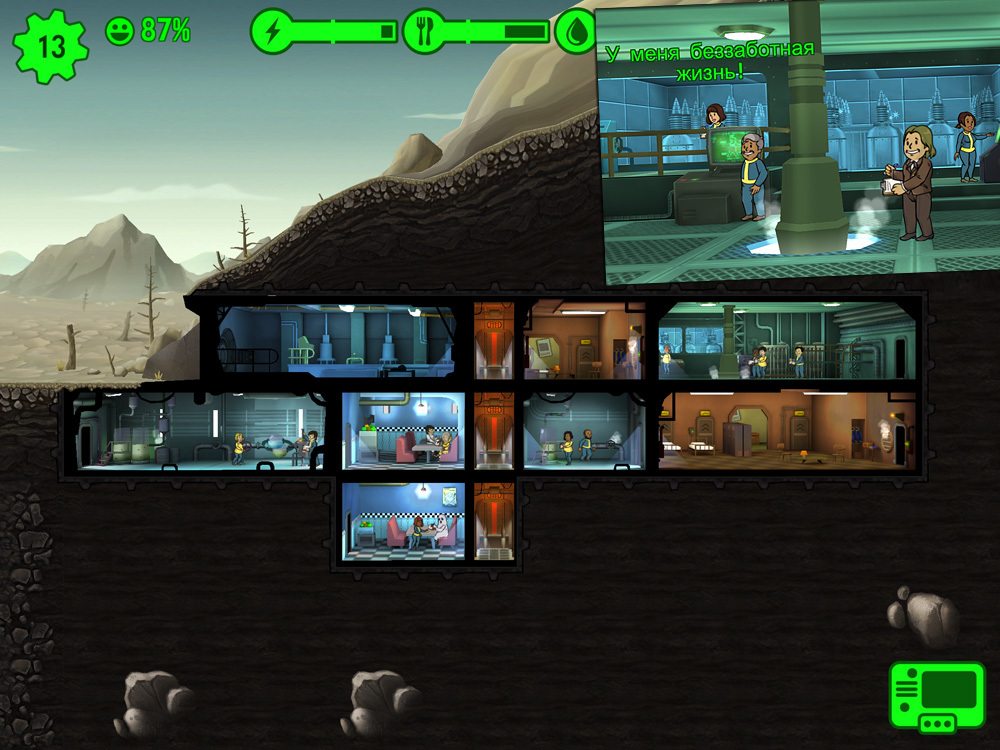

Another separate very cool interface is the radio. First, it is realistic. Secondly, to catch the station, you have to turn the figovin from the side, and not just press the button. When you twist this thing and catch a radio station through noise, the effect of immersion increases:

Overlaying game actions on the interface: music from the radio becomes the background music of the game
Focusing works very well, it’s decided just perfect here. Icons of active actions are shown when they are in your focus, otherwise they collapse to a slowly pulsating point. Look left here:

This is what it is:
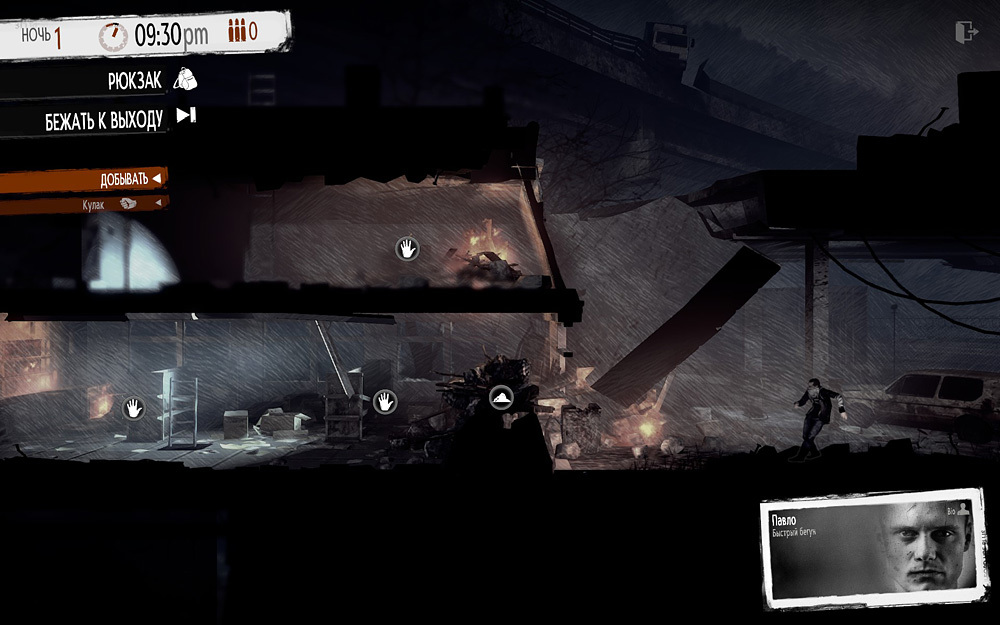
Summer and winter are very different in appearance. Pay attention, by the way, the whole game is textured with a “pencil effect”, and this especially works on the atmosphere:



And finally, we have another purely “desktop” theme - the generation of nightly events. This is just a report of what the rest of the characters did while you were walking on the night exit:

The last part - visual images on the basis of the photo. Portraits are so lively and emotional that they alone create the right atmosphere by themselves.
Climax
Despite the fact that the game very quickly loses its novelty (and in general, like any other plot game , it differs by not very big replayability), thanks to mechanical things it still becomes interesting.
The two most interesting stories are Sveta and Anton (retired) and the "lone wolf." Let's start with retirees. They have almost nothing but a pile of books from a neighbor and beds. They are not fighting at all. Carry very little supplies. They are not able to fight back even from single bandits at night. There are no practical skills - no trading, no mechanics, nothing. They are very, very hard. And at the moment when you play for them, it becomes clear how terrible the war is. And how powerless you are against circumstances.
And at this moment the screenwriter laid wonders:

People come to help our retirees. Do not ask for anything in return. Just come and give away some things. And it changes in general all attitude to the world where you used to literally gnaw every piece of food.
And the second story of a lonely breadwinner is that he is very cool, but being alone, he can do nothing. Out of the house at night - the house was robbed completely. He slept - not strayed from the bandits. Everything valuable must be carried with you. And even a feeble pensioner becomes for him immediately a huge help. This, too, makes it possible, almost on one's own skin, to sense this “teaching team” situation.
Total
It turned out a great educational game, showing everything exactly as it should. Dexterous movements of balance and game mechanics in the direction of "be kind" are not visible at first, and the first 2-3 games (and they don’t play so much) seem like a natural choice. That is, the model of behavior that you convey.

In the western editions (non-player), the game was highly appreciated. But even there the point of view often jumps: it's brilliant, but we won't play the second time - it's terrible, disgusting and scary.
In fact, it was for this that the whole game was made. She is incredibly beautiful and at the same time shows that it is better not to start a war.
And I and you, I think, it was interesting to learn from the experience of a good interface between game subsystems.
Source: https://habr.com/ru/post/269569/
All Articles